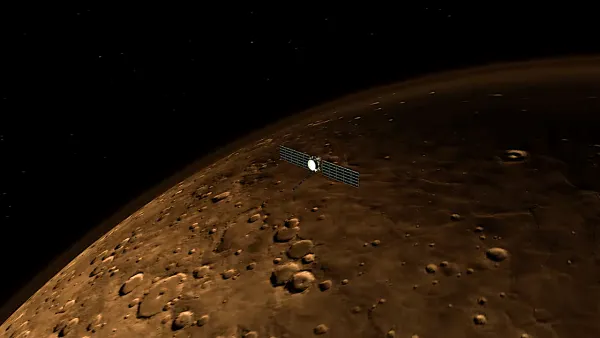
May 17, 2025 — Washington, D.C. – NASA’S Europa Clipper spacecraftcurrently en route to Jupiter’s moon Europahas captured a striking infrared image of Mars during its gravity-assist flyby on March 1, 2025. The flyby not only altered the spacecraft’s trajectory for the next leg of its interplanetary journey but also served as a crucial calibration test for one of its key scientific instruments, E-THEMIS (Europa Thermal Emission Imaging System).
 Mars Flyby Used to Fine-Tune Europa-Bound Instruments
Mars Flyby Used to Fine-Tune Europa-Bound InstrumentsDuring the maneuver, Europa Clipper soared just 550 miles above the Martian surface. Over an 18-minute window, the E-THEMIS instrument captured 1,000 infrared images in greyscalewhich began arriving on Earth by May 5. These observations are being meticulously compared to the thermal data from NASA’s Mars Odyssey Orbiterwhich has been monitoring Mars since 2001.
According to NASA, the match in data confirms that E-THEMIS is functioning precisely, reinforcing confidence ahead of its high-stakes mission to detect potential signs of life on Europa.
 E-THEMIS: A Tool for Tracing Heat and Habitability
E-THEMIS: A Tool for Tracing Heat and HabitabilityE-THEMIS works by detecting infrared radiationallowing scientists to map temperature variations across planetary surfaces. On Mars, this test served as a simulation of its future tasks—spotting thermal anomalies and geologic activity beneath Europa’s icy crust.
Dr. Phil Christensen, principal investigator for E-THEMIS, confirmed the Martian thermal readings matched well with previously mapped datasets from Mars Odyssey, validating the instrument’s performance.
Once at Europa, E-THEMIS will be deployed to identify “hotspots” that could be connected to geological activity or subsurface water movementboth of which are potential indicators of habitable environments.
Europa’s surface is crisscrossed with ridges, cracks, and fracturesbelieved to result from a subsurface ocean exerting pressure on the moon’s icy shell. E-THEMIS aims to track thermal signatures that may hint at recent eruptions or regions where liquid water is migrating upward—key locations in the search for extraterrestrial life.
The flyby also marked the first space test of Clipper’s radar systemdesigned to penetrate Europa’s icy crust and scan for liquid reservoirs beneath. While preliminary data confirms the radar performed well, full results are still under analysis.
 Mission Timeline and Next Steps
Mission Timeline and Next StepsEarth Flyby: Scheduled for 2026
Arrival at Jupiter: April 2030
Mission Goal: Investigate Europa’s habitabilityfocusing on subsurface ocean activity, surface chemistry, and geologic conditions that may support life.
NASA plans to use these insights to guide future lander missions or subsurface probes aimed at detecting biosignatures.
Bhupendra singh chundawat is a seasoned technology journalist with over 22 years of experience in the media industry. He specializes in covering the global technology landscape, with a deep focus on manufacturing trends and the geopolitical impact on tech companies. Currently serving as the Editor at Udaipur kiranhis insights are shaped by decades of hands-on reporting and editorial leadership in the fast-evolving world of technology.